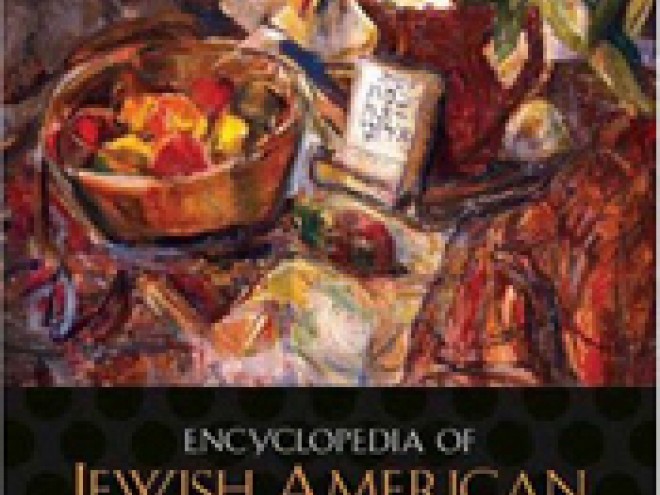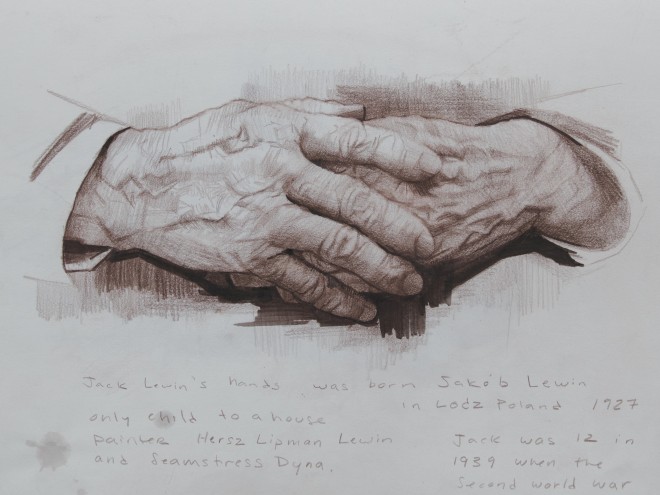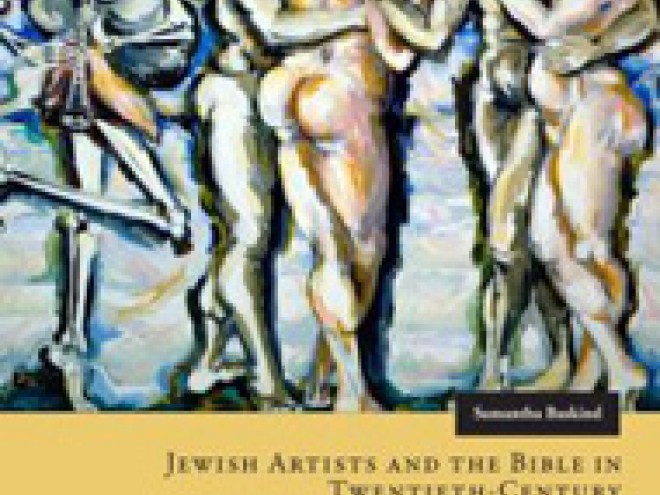Earlier this week, Samantha Baskind wrote about some of the artists she interviewed for Encyclopedia of Jewish American Artists. In the first chapter of her newest book, Jewish Artists and the Bible in Twentieth-Century America, she features the artist Jack Levine. Below, she discusses her experience interviewing Levine for the book. She will be blogging here for the Visiting Scribe series all week.
The first time I spoke with Jack Levine was on October 26, 2004. This was before the Internet made finding people easy, and so I consulted a New York City phone book at a local library in Cleveland. I compiled a list of all the J. Levine’s living in Manhattan (and there were a lot of them) and called each with the preface, rolling off my tongue quickly before I could be hung up on: “Hello, I’m looking for the artist Jack Levine.” After five wrong numbers a gruff voice answered in the affirmative: “That’s me.” I was effusive, explained my purpose (a book I was writing), and we immediately began to talk. I found Jack self-deprecating on that call, and always, and when I asked him why he replied, “It’s all right. It makes you more meaningful.”
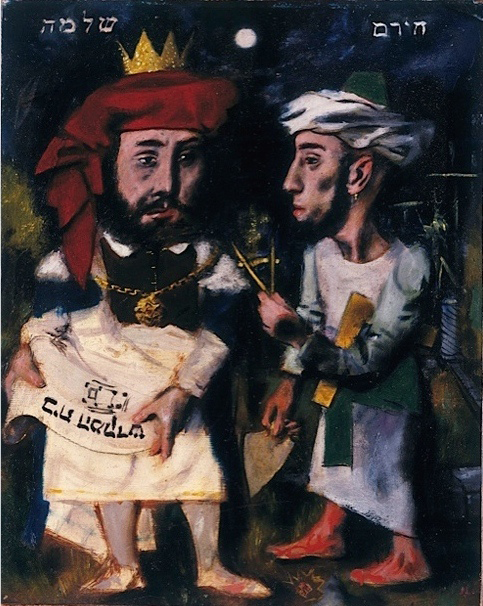
Jack Levine, Planning Solomon’s Temple, 1940.
Oil on masonite, 10 x 8 in. The Israel Museum, Jerusalem.
A few months after that first telephone call, I visited Jack at his Greenwich Village home. What I thought would be an hour or two stay turned into an entire day’s conversation. We sat in his living room, cluttered with volumes of art history books piled up on shelves and the floor. Art he made and that he treasured hung on the walls around me. Candid and charming, Jack shared memories and ideas about his life and art. He spoke of his childhood as the youngest of his Jewish, Lithuanian immigrant parents’ eight children. Jack told me that his parents planned to name him Jacob, after his paternal grandfather, but his Americanized older brother insisted that the newborn be given the more American sounding name: “My oldest brother confused the whole thing, because I guess he felt patriotic.” Retrospectively, Levine noted: “It’s ridiculous. I ought to be alright with the name Jacob.”
While I certainly knew Jack was a consummate draftsman and painter, I soon learned about his vast knowledge and love of art history. We walked up steep stairs to his third-floor studio, a bright open space illuminated by skylights. Jars of colorful paint were stacked on shelves and on available counter space, paintbrushes scattered the floor and were stuffed in miscellaneous containers, and more books overflowed on shelves and tables. He was working on three canvases: a densely painted image of a lion that he had been playing with for years, a portrait of Moses holding the Tablets of the Law, and a scene populated with figures that was taking the form of one of his vintage discourses on human folly. As the sun began to set and I prepared to leave, with several audiotapes full of material and a handful of photographs of Jack, I told him how much I enjoyed our day together. To which he replied with a twinkle in his blue eyes: “You would have enjoyed it more if I wasn’t ninety years old.”
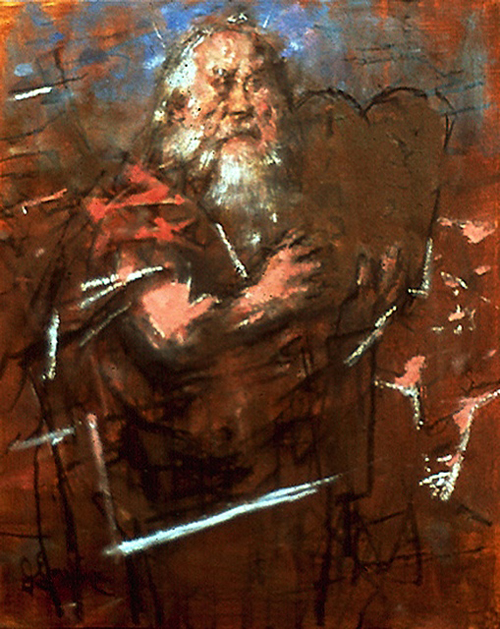
Jack Levine, Moses on Sinai II, 1991.
Oil on canvas, 72 x 63 in. Private collection.
On July 24, 2010, after learning that he was quite ill, I visited Jack again to say goodbye and to pepper him with yet more questions (he died a little over three months later). He still possessed his deadpan wit; after finishing a cup of water he stood up and said, “I need to use the bathroom. I’ll stagger over there now.” Although he was weak, we walked to his favorite restaurant for lunch, an Italian place around the corner from his brownstone where Jack ate nearly everyday, always greeted by the waiters with enthusiasm. Even though it was a sweltering New York summer afternoon, he wore his fedora and sport coat; as usual, he would not leave his home without them on. We talked about printmaking, some of the artists he admired, and why he painted Jewish subjects.Jack believed that the over the ages the Second Commandment prohibited Jewish art and he wanted to do something for his people by filling that gap. Channeling William Wordsworth, he told me that this would be the last time we would be together: “I’ve been lonely as a cloud and it’s time it stopped.” He recalled old friends that day, including Raphael Soyer, a close friend of Jack’s and the artist on whom I wrote my first book.
Raphael Soyer was a topic we addressed on more than one occasion. Jack because he was so fond of Soyer, and I because I welcomed the personal insights after all the years spent researching and writing about him. During my first visit to interview Jack I sat in his living room under a Soyer drawing and he shared a story about a visit he paid the older artist shortly before his death. Jack remembered that in 1987, while keeping Soyer company at his bedside, he took his friend’s hand and kissed it: “Raphael’s hand was the only artist’s hand I ever kissed. In fact, the only other person’s hand I kissed was my father’s.” As I prepared to say my final goodbye to Jack this story came to my mind, and I felt compelled to bestow on him that same gift of admiration and respect. And so I kissed Jack’s hand, one that had painted rich, powerful, and luminous canvases for nearly a century. His hand lingered in mine and the warmth in Jack’s tired eyes betrayed his affection even as he gruffly said “Oy vey.” Jack was still Jack and for that my heart swelled.
As I left, Jack watched me through the window. I finally tore my eyes away and walked through the West Village, unabashedly crying. An extraordinary man with a remarkable history and the last great living figurative artist of mid-twentieth-century American art would soon be gone.
Samantha Baskind is Professor of Art History at Cleveland State University. She is the author of several books on Jewish American art and culture, which address subjects ranging from fine art to film to comics and graphic novels. She served as editor for U.S. art for the 22-volume revised edition of the Encyclopedia Judaica.
Related Content:
- Reading List: Samantha Baskind
- Essays: An Artistic Eye
- Reading List: Jewish Artists
Samantha Baskind is Distinguished Professor of Art History at Cleveland State University. She is the author or editor of six books on Jewish American art and culture, which address subjects ranging from fine art to film to comics and graphic novels. She served as editor for U.S. art for the 22-volume revised edition of the Encyclopaedia Judaica and is currently series editor of Dimyonot: Jews and the Cultural Imagination, published by Penn State University Press.
